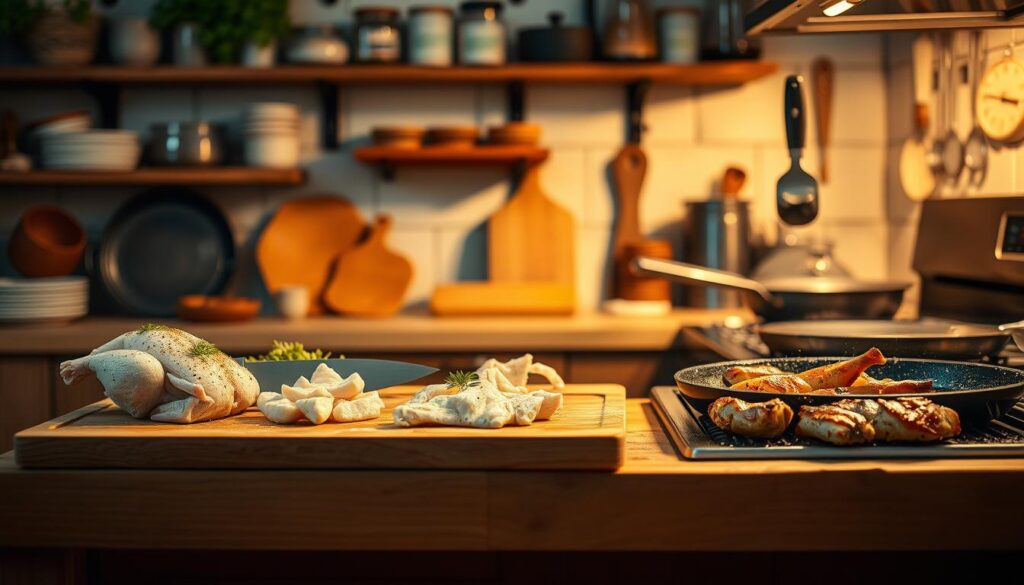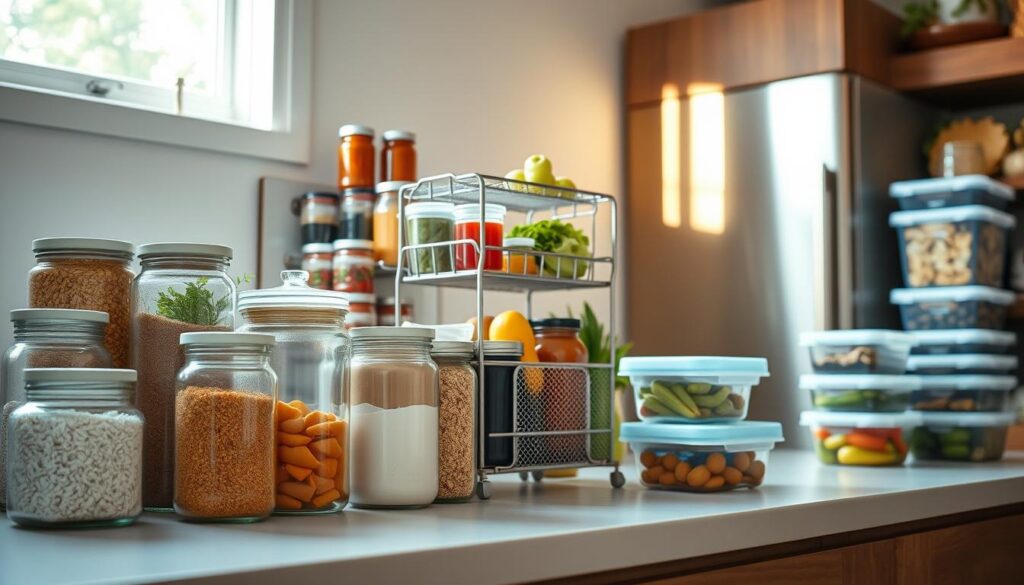Homemade chicken and gravy is a dish that brings warmth and nostalgia. It’s a classic in American cuisine, loved by many. A good homemade gravy can turn a simple chicken dish into a comforting meal.
Chicken recipes are common, but a homemade gravy makes a dish stand out. It’s perfect for a cold winter night or a family gathering. The dish’s rich flavor and tender chicken make it a favorite.
There are many ways to enjoy chicken and gravy, from traditional to modern recipes. Making your own gravy from scratch is rewarding. It’s a way to create a memorable comfort food experience.
Key Takeaways
- Homemade chicken and gravy is a classic American comfort food that evokes feelings of warmth and nostalgia.
- A well-made homemade gravy can make all the difference in a chicken recipe.
- Chicken recipes are a staple in many households, and a great homemade gravy is what sets a good dish apart from a great one.
- Homemade chicken and gravy is the perfect choice for a hearty meal or a comforting dish to serve at a family gathering.
- With the right ingredients and a little practice, anyone can master the art of making delicious homemade chicken and gravy.
- Traditional Southern-style chicken and gravy is a popular variation of this comfort food classic.
- Making homemade gravy from scratch is a simple and rewarding process that can elevate any chicken recipe.
The Art of Making Classic Chicken and Gravy
Classic chicken and gravy is a beloved part of American food. It reminds us of family dinners and traditional cooking. This dish is simple yet rich, letting the flavors of the ingredients stand out.
Chicken and gravy is a favorite for family meals. It brings people together, creating a sense of community. Whether for a big family event or a cozy night in, it’s always a hit. Its versatility makes it perfect for any occasion.
History of This Comfort Food Classic
The story of chicken and gravy is long and rich. It has changed over time, adding flavors from different regions. From the South’s spicy version to the North’s creamy sauces, each area has its own twist.
Why This Dish Remains a Family Favorite
Chicken and gravy is loved for its mix of flavors and textures. It’s more than food; it’s a way to connect with the past. It’s perfect for any family gathering or casual dinner, becoming a staple in your meal plans.
Regional Variations Across America
Chicken and gravy varies greatly across the country. Some like it light, while others prefer it thick and creamy. Yet, its appeal remains strong. Exploring these differences can make your meals more exciting, adding depth to your cooking.
Essential Ingredients for Perfect Chicken and Gravy
To make a tasty homemade chicken and gravy, focus on the quality of your ingredients. This is a key part of cooking techniques. You’ll need fresh veggies, top-notch chicken, and a rich broth. Choosing the right ingredients is key for easy and stress-free cooking.
Start with fresh, hormone-free chicken. Then, add fresh veggies like carrots, celery, and onions. They make the gravy sweet and deep. A good broth is also crucial. You can buy it or make your own with chicken bones and veggies.
When planning your meal planning, think about what you need and how to use it well. For example, use the same veggies for the gravy and as a side. This saves time and cuts down on waste. With quality ingredients and smart meal planning, you’ll make a dish everyone will love.
Don’t forget these key ingredients:
- Fresh herbs like thyme and rosemary
- Aromatics like garlic and onions
- Acidic ingredients like lemon juice or vinegar
These add flavor and complexity to your dish. With these ingredients and good cooking techniques and meal planning, you’ll impress everyone with your homemade chicken and gravy.
Kitchen Tools and Equipment You’ll Need
To make a tasty homemade chicken and gravy, you need the right tools. Having the right kitchen essentials and cooking tools makes cooking easier. It helps you make a perfect dish.
A well-stocked kitchen is key for a great cooking experience. You’ll need whisks, spatulas, and wooden spoons. These tools help you mix, stir, and serve your dish well.
Must-Have Utensils
- Whisk: for mixing the gravy
- Spatula: for flipping the chicken
- Wooden spoon: for stirring the gravy
Optional but Helpful Tools
Tools like immersion blenders can make your gravy smoother. Adding these tools to your kitchen makes cooking easier.
Pan Selection Guide
Choosing the right pan is crucial for perfect chicken and gravy. Cast iron or stainless steel pans are good choices. They heat evenly and can handle high temperatures.
When picking a pan, think about size, material, and durability. Make sure it fits your cooking needs.
| Pan Material | Benefits |
|---|---|
| Cast Iron | Durable, even heat distribution |
| Stainless Steel | Easy to clean, resistant to scratches |
The Best Chicken and Gravy Recipe for Beginners
For those new to easy cooking, a homemade chicken and gravy recipe is perfect. It’s a comfort food classic that’s easy to make. You just need a few simple ingredients to please your taste buds.
To start, gather chicken breasts, flour, butter, and chicken broth. You can also add onions, carrots, and celery for extra flavor. Here’s a simple recipe to follow:
- 2 chicken breasts
- 1 cup of flour
- 2 tablespoons of butter
- 1 cup of chicken broth
Season the chicken with salt and pepper, then coat it in flour. Heat butter in a pan and cook the chicken until it’s browned. Remove the chicken, then add chicken broth for a rich gravy. Serve the chicken with the gravy spooned over the top, and enjoy!
This easy cooking recipe lets you make a delicious homemade chicken and gravy dish. It’s perfect for beginner recipes. So why not try it and make a tasty meal that will become a family favorite?
| Ingredient | Quantity |
|---|---|
| Chicken breasts | 2 |
| Flour | 1 cup |
| Butter | 2 tablespoons |
| Chicken broth | 1 cup |
Mastering the Art of Gravy Making
Gravy making is key to cooking. It can turn a simple dish into something special. The goal with gravy recipes is to get the right consistency. A good gravy is smooth and velvety, without lumps or too much salt.
To get good at sauce making, start with the basics. Use the right stuff like flour and broth. Whisk constantly to avoid lumps. Here are some tips for making smooth gravy:
- Start with a roux, whisking flour and fat together for a smooth paste.
- Slowly add liquid to the roux, whisking all the time to avoid lumps.
- Cook the gravy on low heat, stirring now and then, until it’s just right.
By using these tips and practicing, you’ll make delicious, lump-free gravy. It will make your dishes even better. Always taste and adjust as you go, adding more seasoning or liquid as needed.
With patience and practice, you’ll be a pro at gravy making and sauce making. You’ll be able to make all sorts of tasty sauces and gravies to make your cooking even better.
| Gravy Type | Ingredients | Instructions |
|---|---|---|
| Roux-based Gravy | Flour, fat, broth | Whisk flour and fat together, then gradually add broth |
| Reduction Gravy | Broth, wine, herbs | Cook broth and wine together until reduced, then add herbs |
Tips for Tender, Juicy Chicken
Cooking chicken can be tricky to get it tender and juicy. But, with the right techniques, you can make sure your chicken is always perfect. Remember, don’t overcook it, or it will dry out.
Marinades and brines can make your chicken taste better and stay moist. A marinade is a mix of oil, acid, and spices that the chicken soaks in. A brine is a salty water solution that adds moisture and flavor. These methods help your chicken be tender and full of taste.
You can cook chicken in many ways, like baking, grilling, or pan-frying. The best method depends on the chicken type and what you want. For example, baking or grilling is good for chicken breasts. Pan-frying works better for thighs or wings.

Other tips for tender chicken include using a meat thermometer to check the temperature. Also, don’t overcrowd the pan to prevent steaming instead of searing. By following these tips and techniques, you can make delicious, tender chicken dishes that everyone will love.
- Use marinades and brines to enhance flavor and moisture
- Avoid overcooking the chicken
- Use a meat thermometer to ensure safe internal temperature
- Don’t overcrowd the pan
With a bit of practice and patience, you can become great at cooking tender chicken. These tips and techniques will help you make tasty and memorable chicken dishes. They will become favorites in your family.
Serving Suggestions and Pairings
There are countless ways to serve homemade chicken and gravy. Pair it with different side dishes to make a complete meal. Classic choices like mashed potatoes, green beans, and roasted carrots are always a winner. For something new, try it with roasted veggies or quinoa. These options enhance both taste and looks.
Some great side dishes for chicken and gravy are:
- Garlic bread
- Steamed broccoli
- Sauteed spinach
- Roasted sweet potatoes
Don’t just stick to the usual. Get creative with your plating. Add fresh herbs or a sprinkle of paprika for color. This way, your meal will not only taste great but also look amazing.
Exploring different meal ideas can lead to many tasty dishes. Homemade chicken and gravy can be the star of the show. So, don’t hesitate to try new things. Your taste buds will love it!
Storage and Reheating Guidelines
Keeping your homemade chicken and gravy fresh is key. You can store it in the fridge or freezer. The fridge is best for up to three days. Freezing lets you enjoy it for up to three months.
There are ways to reheat your dish, like using the oven or microwave. Oven reheating keeps the flavors and texture intact. Just preheat to 350°F (180°C), cover, and reheat for 20-25 minutes. Microwave reheating is quicker but be careful not to overheat, which can dry out the chicken.
Proper Storage Methods
- Refrigerate at a temperature of 40°F (4°C) or below
- Freeze at a temperature of 0°F (-18°C) or below
- Use airtight containers to prevent moisture and other flavors from affecting your dish
Best Reheating Practices
To keep your chicken and gravy tasty, follow these reheating tips. Use low to medium heat and stir often to avoid burning. Adding chicken broth or water helps keep it moist and flavorful.

By storing and reheating your chicken and gravy correctly, you can enjoy it for many meals. Always use the right storage and reheating methods to keep your dish safe and delicious.
| Storage Method | Temperature | Shelf Life |
|---|---|---|
| Refrigeration | 40°F (4°C) or below | Up to 3 days |
| Freezing | 0°F (-18°C) or below | Up to 3 months |
Troubleshooting Common Issues
When making homemade chicken and gravy, you might run into some common mistakes. We’ve got some cooking troubleshooting tips to help you out. Whether it’s too salty gravy or overcooked chicken, we’ve got advice for you.
Some common problems include lumpy gravy, underseasoned chicken, or gravy that’s too thin. To avoid these, follow a reliable recipe and prepare your ingredients well. Here are some tips to keep in mind:
- Whisk your gravy constantly to prevent lumps from forming
- Taste and adjust your seasoning as you go to avoid underseasoned chicken
- Use a roux to thicken your gravy and achieve the perfect consistency
By following these tips and being aware of common mistakes, you’ll make a delicious homemade chicken and gravy. Remember, cooking troubleshooting is about patience and getting it right.
Conclusion: Mastering Your Homemade Chicken and Gravy
Learning to make homemade chicken and gravy is an art that’s easy to master. With practice and patience, you can become a pro at comfort food. Enjoy the journey of making this classic dish, try different versions, and share it with those you love.
Whether you’re new to cooking or have years of experience, making your own chicken and gravy is rewarding. It’s about using simple ingredients, enjoying the process, and serving a meal you made yourself. Every bite brings you and your family closer to a cozy, comforting place.
So, get ready to cook up some homemade chicken and gravy. Let it become a special part of your family’s traditions. It’s a way to share good food and make lasting memories. Bon appétit!
FAQ
What are the essential ingredients for perfect chicken and gravy?
For perfect chicken and gravy, you need high-quality chicken and fresh veggies. Also, use broth and the right seasonings for a rich, flavorful gravy.
What kitchen tools and equipment are needed to make homemade chicken and gravy?
You’ll need a whisk, spatula, and measuring cups and spoons. An immersion blender and meat thermometer are optional but helpful. A cast-iron or stainless steel skillet is key for cooking.
How can I achieve the perfect gravy consistency?
To get the perfect gravy, avoid lumps and over-thickening. Gradually add broth and use a roux to master gravy making.
What are some tips for cooking tender, juicy chicken?
For tender chicken, don’t overcook it. Brine the chicken and use marinades for flavor and moisture. Choose the right cooking method, like baking or pan-frying.
What are some traditional and modern serving suggestions for chicken and gravy?
Serve with mashed potatoes, green beans, and biscuits for a traditional meal. For a modern twist, try roasted veggies, quinoa, or a fresh salad. Garnish with fresh herbs or drizzle gravy artfully.
How should I store and reheat leftover chicken and gravy?
Store leftovers in an airtight container in the fridge for 3-4 days or freeze for longer. Reheat in the oven or microwave to keep flavor and texture.
What are some common issues I might encounter when making chicken and gravy, and how can I troubleshoot them?
Issues like too-salty gravy, overcooked chicken, and lumps can happen. Adjust seasoning, cooking time, and thickening to fix these problems and enjoy perfect homemade chicken and gravy.

